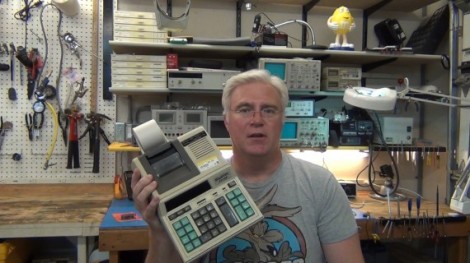
This printing calculator is a thrift store find. [Todd Harrison] picked it up for a measly $3, and it still works! But the device is about twenty years old and he thinks it’s time to clean up the aging hardware.
After cracking open the case he digs out some of the stuff that has made its way inside. This includes a few dried up moths (debugging complete). While everything is open he gives a tour of the components. The calculator has a VFD which is definitely worth the price tag of the unit even if you just want to reuse the display in another project. But that’s not all. The printing head would be a fun thing to play with as well. We could see using this in projects similar to some of the thermal printer hacks we’ve seen.
When put back together, and given a new ink ribbon, the unit is ready for another 10-years of holding down one corner of your desk. Don’t miss [Todd’s] tear-down and clean-up video after the break.
















Sometimes things like that sit around for years without being used, and then get unceremoniously dumped without considering the value of the parts.
I guess the mind that says “this will be useful someday” makes the decision that it is no longer useful and gets rid of it leaving out the interim decision of “what useful parts can I get from this before dumping it?”
I wonder what other things around my shop/house/garage, besides a printing calculator,are in a similar state.
I remember reading in an electronics magazine decades ago about converting a cheap calculator into a capacitance meter.
P.S. nice bench Todd!
It’s about the mind-set of the one doing the throwing away. If you’re an every day user of the object in question, with no interest in hacking stuff, the notion of recycling parts of something doesn’t enter your mind, you just focus on the exterior of the object and your daily use of it. I cry about some of the stuff I mercilessly threw away before the notion got into me that I could actually make something else out of what was broken or obsolete.
I nearly always strip stuff down before binning it. If nothing else, it gives you a great insight into how to strip stuff down.
You sometimes find real gems that you wouldn’t expect.
But just the skill of taking something apart is apparently not well known. I’m amazed at the number of youtube vides there are that explain how to strip stuff and there are loads of “thanks for that I needed it” comments. I only needed to use one recently because taking a laptop apart I hadn’t found the split between the keyboard and the cover and thought they were part of the same unit. It was a new laptop so I was a bit overcautious!
I’ve been giving Craftsman hand tools to a godson as presents since he was an infant. Now 8 y.o., he loves to take stuff apart with them, so his dad (PhD. EE) finds stuff for him and oversees the process.
This is more valuable than it might seem.
I have learned how to carrefully take some things apart without damaging them by experimenting first with useless things of the same category.
Its Really nice to first try stripping something you would have thrown away anyways, before risking the good stuff.
If anyone has actually taken VFDs off devices like this and re-purposed them without weird custom driver circuits and absurd amounts of effort please post project pages. Spritesmods made one a custom controller but that was way more work than is worth it for a salvaged numeric display imo.
Last time I picked up a calculator like that I was disappointed with the single-chip that ran calculations, display, and printing.
Amen to that. Lots of components are theoretically fun to reuse but practically require so much effort (read: “so many new parts”) that it’s a losing proposition. VFD’s are *lovely* but driving them is as complicated as driving nixies. Turning this calculator printer into something similar to a thermal printer is a pipe dream– it can only do digits.
VFD’s are not “as hard to drive as nixies” !
actualy they’r “as easy to drive as nixies” !
simple transistor per control wire to the display, multiplexed just like an LED display.
in fact, its eaiser to control then a nixie!
the nixie needs over 50 volts! the VFD can work on as little as 12v(dim) or 24v(super-bright)
and those parts to control the VFD dont _HAVE_ to be new… free ones are on the curb just waiting to be used in a VFD project
I do have an old epson printe m80 mechanism that look the one on the photo….but my control board is dead.. does someone know how to control it using PIC/arduino ?